

 1921 Street
Directory of St George's Street
1921 Street
Directory of St George's Street
 This list shows that most of the small businesses, and some of the
pubs, were
Jewish-run, with a sprinking of Irish. Premises were generally very
small. Right is
a general
view from 1928. Premises were renumbered some time in the 1920s. A
'chandler's shop' was a general store, not specifically marine. See
the notes below on some of the occupants. Left is Goad's 1887 insurance map of the street - W and E of Cannon Street Road, showing the location of Harris Terrace, Russell Court and Ratcliff Street. The transciption is partly based on this excellent website.
This list shows that most of the small businesses, and some of the
pubs, were
Jewish-run, with a sprinking of Irish. Premises were generally very
small. Right is
a general
view from 1928. Premises were renumbered some time in the 1920s. A
'chandler's shop' was a general store, not specifically marine. See
the notes below on some of the occupants. Left is Goad's 1887 insurance map of the street - W and E of Cannon Street Road, showing the location of Harris Terrace, Russell Court and Ratcliff Street. The transciption is partly based on this excellent website.|
NORTH SIDE [E-W from
Dellow Street to Well Street] |
SOUTH SIDE [W-E from Virginia Street to West Gardens]
|
[1] Charles
Dickens
Jnr's Dictionary of
London (1879), in the section on common lodging houses regulated
under Lord Shaftesbury's Acts of 1851 and 1853, notes
| About the best sample of this kind of establishment extant will be found at St. George's chambers, St. George's-street, London-docks (vulgo, Ratcliff-highway), a thorough poor man's hotel where a comfortable bed with use of sitting-room, cooking apparatus and fire, and laundry accommodation, soap included, can be had for 4d. a night, all kinds of provisions being obtainable in the bar at proportionate rates. To any one interested in the condition of the London poor, this establishment is well worth a journey to the East-end to visit. |
At an earlier
stage in their career they were successful defendants in an intriguing
legal case, Trustees of
St. Saviour's Rectory and Oyler (1886), 31 Ch. D. 412. The Cross Bones Burial
Ground in Southwark [now Redcross Way] was an ancient unconsecrated
burial ground for single women - i.e. prostitutes, known as Winchester
Geese
because from 1161 to the 17th century the Bishop of Winchester (in
whose diocese Southwark
then fell - its largest city) had licensed their activities by Royal
Ordinance to work in the Liberty of the Clink, where activities banned
within the City flourished. By the 18th century it had become a burial
ground for paupers and the Irish poor, with over 15,000 burials, and
became very insanitary - see George Walker's 1839 Gatherings
from Graveyards
for the gruseome details and the parish vestry's mercenary plan to
re-use part of it.
It was finally closed by Order in Council in 1853. A local Act of
Parliament, the St Saviour's Southwark (Church Rate Abolition Act)
1883, transferred ownership from the wardens and gave new trustees
title to the land; they advertised it for sale, stating that although
it was indeed a former burial ground, it had since been occupied by a
contractor, and was specially suited for a builders' or timber yard.
Thomas and George Olyer signed a contract, paying a deposit of £230 on
the £2300 purchase price. However, the Disused
Burial Grounds Act 1884 had come into force, s3 of which provided After
the passing of this Act is shall not be lawful to erect any buildings
upon any disused burial ground, except for the purpose of enlarging a
church, chapel meeting-house, or any other place of worship,
though s5 made an exception for any burial ground sold or disposed of
under the authority of an Act of Parliament. 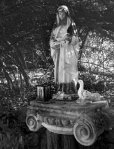 The
Oylers refused to
complete, because of this uncertainty (and there were also local
objections, led by Lord Brabazon, who wrote to The Times with a view to save this ground from such
desecration, and to retain it as an open space for the use and
enjoyment of the people). The
first court held in the trustees' favour, arguing that they had
made the position clear, and that s5 applied to a disposal under the
1883 local Act. But in the High Court Vice-Chancellor Bacon ruled that
s5 only applied to a disposal made before the Disused Burial Grounds
Act came into force. (North J dissented on this point, and later cases
- of which there have been many - followed his interpretation.) So the
contract could not be enforced, and costs were awarded against the
trustees. Part of the site was later sold by
auction to the District Railway Company in 1892, and fairs were
held on the rest of the site. In more recent
times, further attempts to build have been made, which have been
strongly resisted by local people, apparently with support from the
Mayor of London; though concreted over, it has become a focus for
Hallowe'en
and other secular/pagan rituals for 'The Outcast Dead', detailed here, and the railings are
permanently festooned with ribbons, with a small figure of the Virgin
Mary and porcelain and wooden
geese [right] set within.
The Museum of London Archaeology service excavated the site between
1991-98, in connection with the building of the Jubilee line - many of
photos here, graphically
showing the diseased state of the human remains. See this blog for the latest news. The
Oylers refused to
complete, because of this uncertainty (and there were also local
objections, led by Lord Brabazon, who wrote to The Times with a view to save this ground from such
desecration, and to retain it as an open space for the use and
enjoyment of the people). The
first court held in the trustees' favour, arguing that they had
made the position clear, and that s5 applied to a disposal under the
1883 local Act. But in the High Court Vice-Chancellor Bacon ruled that
s5 only applied to a disposal made before the Disused Burial Grounds
Act came into force. (North J dissented on this point, and later cases
- of which there have been many - followed his interpretation.) So the
contract could not be enforced, and costs were awarded against the
trustees. Part of the site was later sold by
auction to the District Railway Company in 1892, and fairs were
held on the rest of the site. In more recent
times, further attempts to build have been made, which have been
strongly resisted by local people, apparently with support from the
Mayor of London; though concreted over, it has become a focus for
Hallowe'en
and other secular/pagan rituals for 'The Outcast Dead', detailed here, and the railings are
permanently festooned with ribbons, with a small figure of the Virgin
Mary and porcelain and wooden
geese [right] set within.
The Museum of London Archaeology service excavated the site between
1991-98, in connection with the building of the Jubilee line - many of
photos here, graphically
showing the diseased state of the human remains. See this blog for the latest news. |
 [2]
Dickson & Head were also described as glass and lead pipe merchants and
as glass benders and blowers. The had been one of only three regular advertisers in the parish magazine during the 1890s - left. Thomas Dickson was the
father-in-law and employer of Gustav Degerlund, whose family were
closely associated with St George-in-the-East. The Medical Times & Gazette reported in 1881 An example worthy of imitation has been
set by Messrs. Dickson and Head,
of St. George-street, E. They
have just forwarded contributions (the result of collections made In
boxes fixed in their counting-house) to the following institutions:-
Five guineas to the London Hospital, four guineas to the East London
Hospital for Children, four guineas to the Victoria-park Hospital,
and four guineas to the Poplar Hospital for Accidents - making in all
seventeen guineas. In
1918 the Board of Trade licensed the firm under the Non-Ferrous Metal
Industry Act of that year; but the company was voluntarily wound up in
1924.
[2]
Dickson & Head were also described as glass and lead pipe merchants and
as glass benders and blowers. The had been one of only three regular advertisers in the parish magazine during the 1890s - left. Thomas Dickson was the
father-in-law and employer of Gustav Degerlund, whose family were
closely associated with St George-in-the-East. The Medical Times & Gazette reported in 1881 An example worthy of imitation has been
set by Messrs. Dickson and Head,
of St. George-street, E. They
have just forwarded contributions (the result of collections made In
boxes fixed in their counting-house) to the following institutions:-
Five guineas to the London Hospital, four guineas to the East London
Hospital for Children, four guineas to the Victoria-park Hospital,
and four guineas to the Poplar Hospital for Accidents - making in all
seventeen guineas. In
1918 the Board of Trade licensed the firm under the Non-Ferrous Metal
Industry Act of that year; but the company was voluntarily wound up in
1924.
[4] The Half Moon
and Seven Stars was
long-established; along with other pubs in the first half of the 19th
century, it was a recruiting base for ships' crews: here is a placard
from 1816:
| Who would
enter for a small craft? whilst the Leander,
the finest and
fastest sailing frigate in the world, with a good spar deck overhead to
keep you dry, warm, and comfortable; and a lower deck like a barn,
where you may play at leap-frog when the hammocks are hung up; has room
for 100 active, smart seamen, and a dozen stout lads for royal yard
men. This wacking [sic]
double-banked frigate is fitting at Woolwich to
be flagship on the fine, healthy, full-bellied Halifax station, where
you may get a bushel of potatoes for a shilling, a cod-fish for a
biscuit, and a glass of boatswain's grog for twopence. The officers'
cabins are building on the main deck, on purpose to give every tar a
double berth below. Lots of leave on shore; dancing and fiddling on
board; and 4 lbs. of tobacco served out every month. A few strapping
fellows, who would eat an enemy alive, wanted for the admiral's barge.
The officers already appointed are Captain Skipsey, late Maidstone; Lieutenant J. P. Baker,
late Royal Sovereign, Rippon
and Barham, H.
Walker, late Courageaux, and Menelaus; J. S. Dixon, late Caledonia and San Joseph; A.P. Le Neve, late Maidstone; E. A.
Haughton, late St Lawrence,
and Princess Charlotte (on
the Lakes),
who will give every encouragement to their old shipmates. Every good
man is almost certain of being made a warrant officer, or getting a
snug berth in Halifax dockyard. All brave volunteers whom this may suit
must bear a hand, and apply either on board the Leander, at Woolwich; at her
rendezvous, the Half
Moon and Seven Stars, Ratcliffe Highway, nearly opposite Old Gravel
Lane; on board the Enterprise,
off the Tower; or at any other general rendezvous in the kingdom, from
whence they will be immediately forwarded to the Leander]. God
save the King !!
The Leander, and a full-bellied station !!! |

 [5] By
1855 J. Dodsworth had set up
business as a printer at 52 Cannon Street
Road; the family were supporters of the British
& Foreign Bible
Society (as it was then known), and their Christian commitment is
reflected in some of the material they printed
down the years. By the 1890s they had moved to more commodious premises at 127
and 127a Ratcliff Highway, where as steam
printers they
produced material for the Revd Peter Thompson, including,
for
instance, his 96-page London Wesleyan Mission (East) Record of Work,
with facts and incidents for 1892-93. Other publications
from this period included W. Grey's pamphlet
The West Indies: A Paper
Read at the Annual Festival of the Dorchester
Missionary College (1884) and John T. Medhurst Rules and Hints for Beginners
and Elementary
Students: Being Notes of Lectures Delivered at the City of London
College (a 44 page booklet on book-keeping, 1888).
[5] By
1855 J. Dodsworth had set up
business as a printer at 52 Cannon Street
Road; the family were supporters of the British
& Foreign Bible
Society (as it was then known), and their Christian commitment is
reflected in some of the material they printed
down the years. By the 1890s they had moved to more commodious premises at 127
and 127a Ratcliff Highway, where as steam
printers they
produced material for the Revd Peter Thompson, including,
for
instance, his 96-page London Wesleyan Mission (East) Record of Work,
with facts and incidents for 1892-93. Other publications
from this period included W. Grey's pamphlet
The West Indies: A Paper
Read at the Annual Festival of the Dorchester
Missionary College (1884) and John T. Medhurst Rules and Hints for Beginners
and Elementary
Students: Being Notes of Lectures Delivered at the City of London
College (a 44 page booklet on book-keeping, 1888). 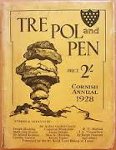 In
an article about W.H. Amery, who had served his apprenticeship as a
compositor and printer with Dodsworths and went on to run letterpress
classes at the Aldenham Institute, the British Printer of 1898 said
that they may be aptly
described as a
highly respected firm of printers and stationers doing a general
commercial business. As part of their wider business, they
supplied pen nibs for Post Office use [left,
c1910]. Among later publications were Willis MacNichol A Key to the Mysteries of
Divination (1924) and in the 1920s the Cornish Annual Tre, Pol and Pen [right] and the Grocer's Year Book: The
Standard Book of Reference for the Grocery and Allied Trades.
The firm went into voluntary liquidation in 1932.
In
an article about W.H. Amery, who had served his apprenticeship as a
compositor and printer with Dodsworths and went on to run letterpress
classes at the Aldenham Institute, the British Printer of 1898 said
that they may be aptly
described as a
highly respected firm of printers and stationers doing a general
commercial business. As part of their wider business, they
supplied pen nibs for Post Office use [left,
c1910]. Among later publications were Willis MacNichol A Key to the Mysteries of
Divination (1924) and in the 1920s the Cornish Annual Tre, Pol and Pen [right] and the Grocer's Year Book: The
Standard Book of Reference for the Grocery and Allied Trades.
The firm went into voluntary liquidation in 1932.
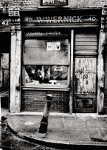
 [8] Wernick's had
various shops around the area - right
are Spitalfields and (next to a synagogue entrance) Bethnal Green in
latter years.
[8] Wernick's had
various shops around the area - right
are Spitalfields and (next to a synagogue entrance) Bethnal Green in
latter years.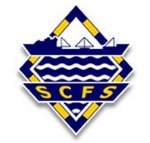 [10] The origins of
the SCFS are summarised here.
Their premises were a former sugar warehouse immediately opposite the
Docks entrance; in addition to the chapel and reading room, they had
run an educational institute, with weekly lectures on various subjects,
and gave temporary support. George John Hill was the secretary for 60
years from 1886, succeeding his father George Teil Hill who had been a
colleague of 'Bo'sun'
Smith.
[10] The origins of
the SCFS are summarised here.
Their premises were a former sugar warehouse immediately opposite the
Docks entrance; in addition to the chapel and reading room, they had
run an educational institute, with weekly lectures on various subjects,
and gave temporary support. George John Hill was the secretary for 60
years from 1886, succeeding his father George Teil Hill who had been a
colleague of 'Bo'sun'
Smith.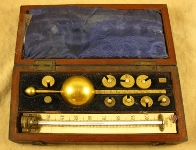 [12] Caney & Briggs were also listed
as chemists and druggists; a
Sikes hydrometer
of around 1900, with brass float, weights, thermometer and rules, in a
mahogany case labelled 'Caney & Briggs, London', was sold at
auction a few years ago. Bartholomew Sikes' instrument was the
industry-standard equipment for determining the strength of spirits,
providing an accurate method of determing alcohol proof, strength and
percentages from 1816 to 1907, and continued in use until more recent
times.
[12] Caney & Briggs were also listed
as chemists and druggists; a
Sikes hydrometer
of around 1900, with brass float, weights, thermometer and rules, in a
mahogany case labelled 'Caney & Briggs, London', was sold at
auction a few years ago. Bartholomew Sikes' instrument was the
industry-standard equipment for determining the strength of spirits,
providing an accurate method of determing alcohol proof, strength and
percentages from 1816 to 1907, and continued in use until more recent
times.| On and
after the 29th September 1889, it
will be unlawful for any one to sell, offer, expose, or keep for sale
any horse-flesh for human food elsewhere than in a shop, stall, or
place, over or upon which there shall be at all times painted, posted,
or placed, in legible characters of not less than four inches in
length, and in a conspicuous position, and so as to be visible
throughout the whole time, whether by night or day, during which such
horse-flesh is being offered for sale, words indicating that
horse-flesh is sold there. And no one is to supply horse-flesh for human food, to any purchaser who has asked to be supplied with some meat other than horse-flesh, or with some compound article of food which is not ordinarily made of horse-flesh. For the purposes of the Act, the term 'horse-flesh' is to include the flesh of asses and mules, and shall mean horse-flesh, cooked or uncooked, alone, or accompanied by, or mixed with any other substance. |
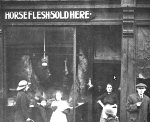 This
was motivated not so much by ahorrence of eating horsemeat as by
public health concerns and the establishment of inspection regimes, and
was one of many
similar pieces of late-Victorian regulatory legislation (another act
covered margarine) - though
it failed to address the slaughtering of decrepit animals in knackers'
yards. Increasingly horseflesh was for pet rather than human
consumption, though during the First Word War 'Belgian butchers'
appeared. By the 1920s 'horseflesh sold here' signs were disappearing,
but the trade lingered on, in separate rather than standard
butchers' shops. It was not rationed during the Second World War,
though sellers had to be licensed; the meat could not be sold on the
bone.
2013 has re-awakened these issues!
This
was motivated not so much by ahorrence of eating horsemeat as by
public health concerns and the establishment of inspection regimes, and
was one of many
similar pieces of late-Victorian regulatory legislation (another act
covered margarine) - though
it failed to address the slaughtering of decrepit animals in knackers'
yards. Increasingly horseflesh was for pet rather than human
consumption, though during the First Word War 'Belgian butchers'
appeared. By the 1920s 'horseflesh sold here' signs were disappearing,
but the trade lingered on, in separate rather than standard
butchers' shops. It was not rationed during the Second World War,
though sellers had to be licensed; the meat could not be sold on the
bone.
2013 has re-awakened these issues!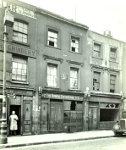 [16] The Rowing
Engineering Company were bakery engineers; the company was
dissolved in 1939. Their blitzed premises are shown right in 1943, next to the
successors of Aaron Joseph
& Son (as his grindery had become). Until about 1900, these had
been the premises of Herbert and Sons, scalemakers - more information,
and a photo from c1870, here.
[16] The Rowing
Engineering Company were bakery engineers; the company was
dissolved in 1939. Their blitzed premises are shown right in 1943, next to the
successors of Aaron Joseph
& Son (as his grindery had become). Until about 1900, these had
been the premises of Herbert and Sons, scalemakers - more information,
and a photo from c1870, here. [18] George Harvey & Son - right - had advertised in the parish magazine until February 1896 when their space suddenly became blank - what had happened?
[18] George Harvey & Son - right - had advertised in the parish magazine until February 1896 when their space suddenly became blank - what had happened?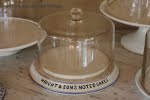
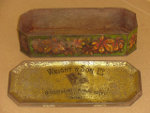 [21] The small firm of Wright & Son
established itself selling tins of biscuits, and
also a cheddar sandwich biscuit - 'a meal for a penny'. The 'son' of
the title was T.R. Wright, who had a sharp marketing mind. In the
Jewish East End, shops sold out before Passover. One Passover, as soon
as the sun had set marking its conclusion, Wright sent his vans around
the
area; one traveller alone sold £300 of goods, and next day their
competitors found all the shops fully stocked. The firm merged with
locally-based Meredith and Drew in 1905 - see here for more details - but Wright & Son remained
as a
subsidiary title to preserve goodwill, and Wright became a dynamic managing
director. In 1967 it became part of United Biscuits; mergers and
takeovers have continued in the trade ever since.
[21] The small firm of Wright & Son
established itself selling tins of biscuits, and
also a cheddar sandwich biscuit - 'a meal for a penny'. The 'son' of
the title was T.R. Wright, who had a sharp marketing mind. In the
Jewish East End, shops sold out before Passover. One Passover, as soon
as the sun had set marking its conclusion, Wright sent his vans around
the
area; one traveller alone sold £300 of goods, and next day their
competitors found all the shops fully stocked. The firm merged with
locally-based Meredith and Drew in 1905 - see here for more details - but Wright & Son remained
as a
subsidiary title to preserve goodwill, and Wright became a dynamic managing
director. In 1967 it became part of United Biscuits; mergers and
takeovers have continued in the trade ever since.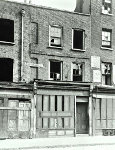
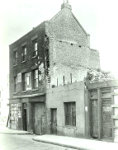
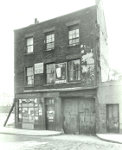
 Left is
no.211 in 1943 after bomb damage, and two images of no.210 in 1953.
Right are nos.201-207 in the same year, on the site now occupied by St
George's Pools. The entrance to Harris Terrace
can be seen to the right of Stratton's glassware factory - one of the
few courts that had survived. Here are a few 'snapshots' of the variety
of people who lived in Harris Terrace a century earlier.
Left is
no.211 in 1943 after bomb damage, and two images of no.210 in 1953.
Right are nos.201-207 in the same year, on the site now occupied by St
George's Pools. The entrance to Harris Terrace
can be seen to the right of Stratton's glassware factory - one of the
few courts that had survived. Here are a few 'snapshots' of the variety
of people who lived in Harris Terrace a century earlier.Back to Ratcliff Highway | Back to East Smithfield